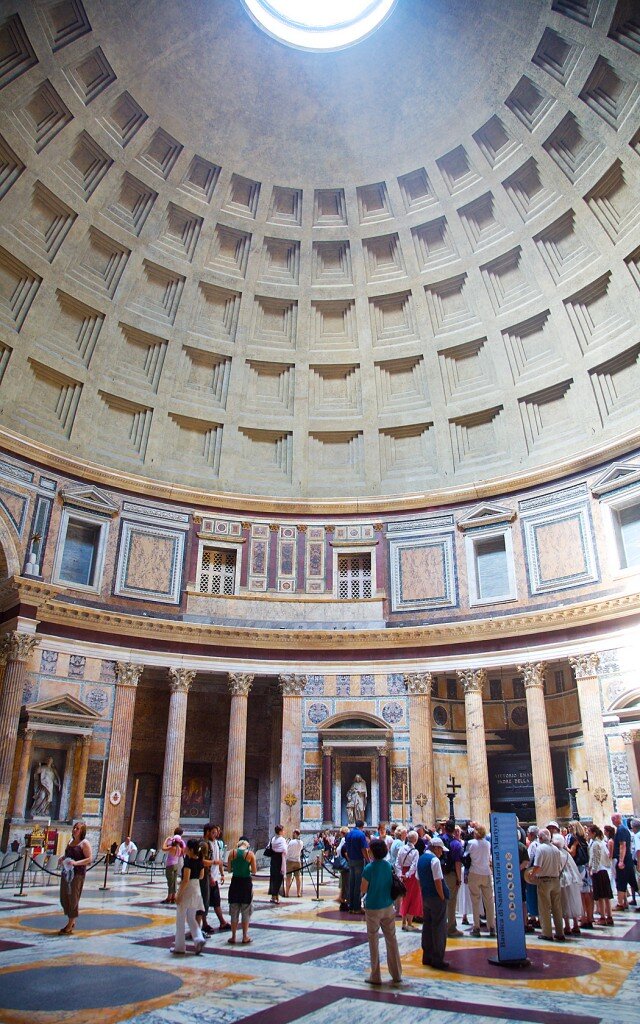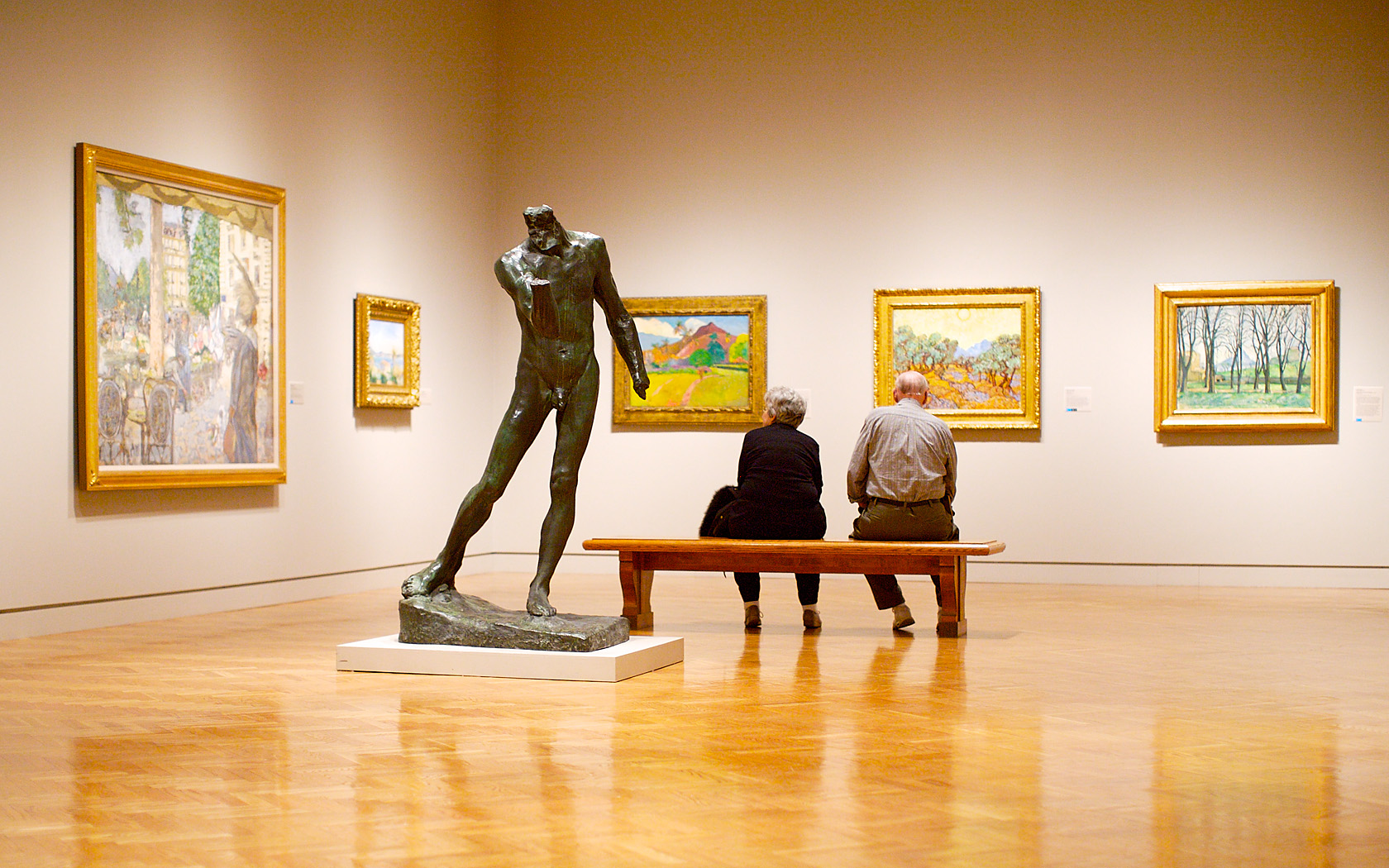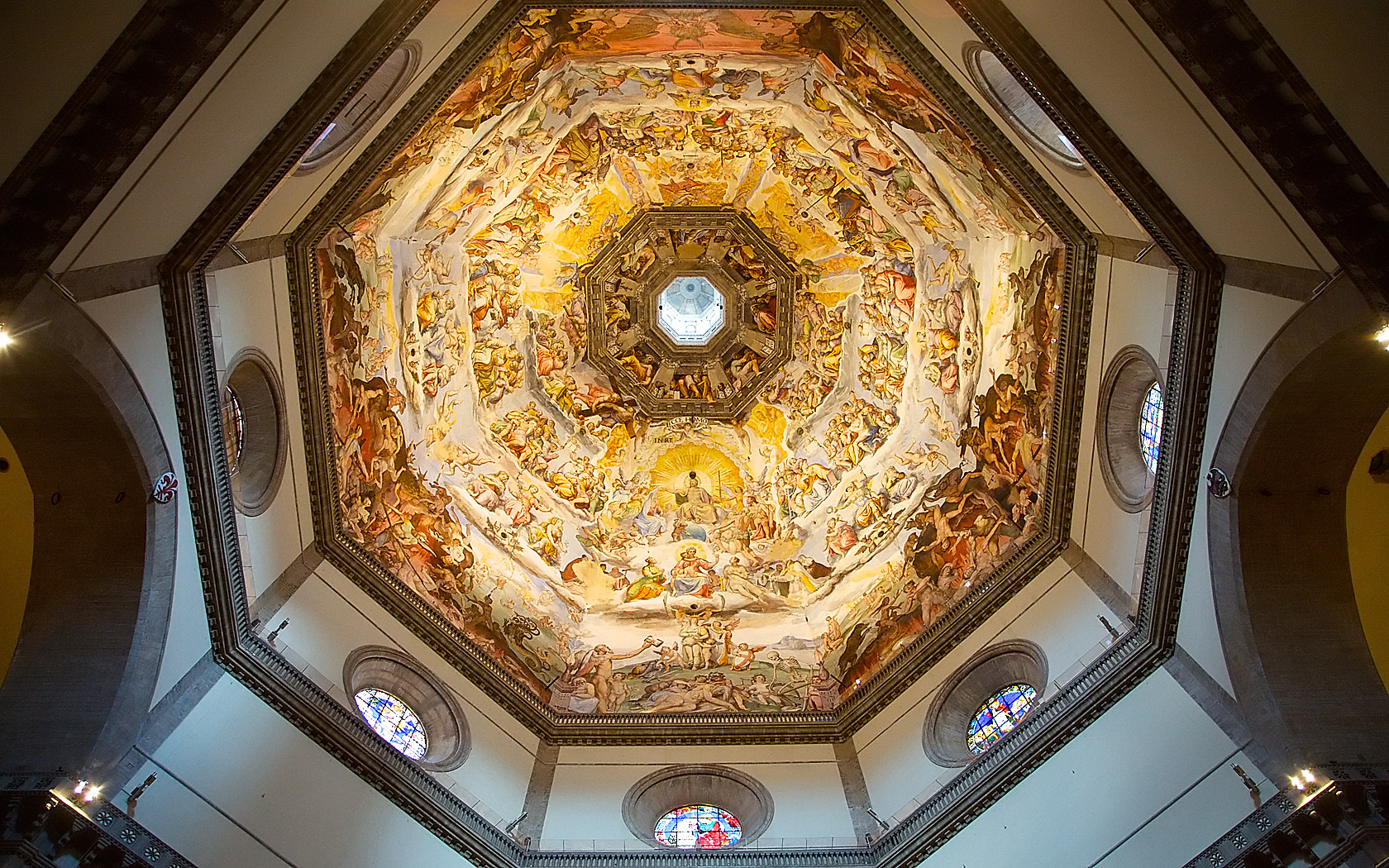 This is the Pantheon in Rome and was built about 2000 years ago. The name means "to all the gods" and the structure was built by people who worshipped a multitude of gods and spirits. Much later in its history, the Pantheon became a Christian church but today it is a tourist attraction and a burial place.* And, if you ask me, it is an architectural marvel - even after 2000 years.If it looks amazing today, imagine walking into this space when it was decorated with statues of Roman deities and with the coffered dome covered in brilliant gold leaf. There is no doubt that this is my favorite ancient building. And, in case you are wanting to see more, I have a previous post in this blog extolling the Pantheon. Finally, if you like to make comparisons, check out this spectacular Chicago structure and discuss.*Italian Kings Vittorio Emanuele II and Umberto I; the Great Renaissance artist Raphael (also a Ninja Turtle)
This is the Pantheon in Rome and was built about 2000 years ago. The name means "to all the gods" and the structure was built by people who worshipped a multitude of gods and spirits. Much later in its history, the Pantheon became a Christian church but today it is a tourist attraction and a burial place.* And, if you ask me, it is an architectural marvel - even after 2000 years.If it looks amazing today, imagine walking into this space when it was decorated with statues of Roman deities and with the coffered dome covered in brilliant gold leaf. There is no doubt that this is my favorite ancient building. And, in case you are wanting to see more, I have a previous post in this blog extolling the Pantheon. Finally, if you like to make comparisons, check out this spectacular Chicago structure and discuss.*Italian Kings Vittorio Emanuele II and Umberto I; the Great Renaissance artist Raphael (also a Ninja Turtle)
Architecture
Toilet Twitter
 Today's social tools, like facebook and Twitter, help keep people in touch with each other in ways that are sometimes astounding. But people of our time might be equally astounded to learn how ancients kept in touch. Of course they chatted along the streets, in the bars and in the public meeting places, just as we do.But they also chatted in the public rest rooms. Talk about the weather and politics would have gone hand in hand with performing basic body functions. Men and women, rich and poor and old and young would have sat cheek to cheek (sorry, but I had to use that expression) in bathrooms much like this.Where are we in this photo? This is the well-preserved Roman city of Ephesus, where the apostle Paul lived and worked. Ephesus is in modern day Turkey and was a stop on our 10 day cruise of the Greek islands. My students are good natured about posing on the ancient toilets. But they were a bit embarrassed. I hope that making this moment public doesn't further embarass them.Incidentally, this blog post goes out to my first block world history class, whom I am teaching about blogging and RSS feeds. The first person in that class to post a response to this blog gets to take the iPad home for a day or two!
Today's social tools, like facebook and Twitter, help keep people in touch with each other in ways that are sometimes astounding. But people of our time might be equally astounded to learn how ancients kept in touch. Of course they chatted along the streets, in the bars and in the public meeting places, just as we do.But they also chatted in the public rest rooms. Talk about the weather and politics would have gone hand in hand with performing basic body functions. Men and women, rich and poor and old and young would have sat cheek to cheek (sorry, but I had to use that expression) in bathrooms much like this.Where are we in this photo? This is the well-preserved Roman city of Ephesus, where the apostle Paul lived and worked. Ephesus is in modern day Turkey and was a stop on our 10 day cruise of the Greek islands. My students are good natured about posing on the ancient toilets. But they were a bit embarrassed. I hope that making this moment public doesn't further embarass them.Incidentally, this blog post goes out to my first block world history class, whom I am teaching about blogging and RSS feeds. The first person in that class to post a response to this blog gets to take the iPad home for a day or two!
Something Old and Something New
 This is a shot from the south (?) side of the River Thames. The structure spanning the river is a pedestrian bridge known as the Millennium Bridge, build to help commemorate the new Millennium a few years ago. In the distance is St. Paul's Cathedral, which was built in 1697 and was designed by the famous British architect Christopher Wren.When the Millennium Bridge opened, they found that it wobbled excessively and millions of dollars were spent on modifications in order for people to safely walk on it. St. Paul's does not wobble and never has.See this on Panoramio and Google Earth
This is a shot from the south (?) side of the River Thames. The structure spanning the river is a pedestrian bridge known as the Millennium Bridge, build to help commemorate the new Millennium a few years ago. In the distance is St. Paul's Cathedral, which was built in 1697 and was designed by the famous British architect Christopher Wren.When the Millennium Bridge opened, they found that it wobbled excessively and millions of dollars were spent on modifications in order for people to safely walk on it. St. Paul's does not wobble and never has.See this on Panoramio and Google Earth
Old Stone
 I posted a stone carving from a building in Chicago yesterday and observed that it was done in an "era when there was time, talent and money to hand carve decorations for skyscrapers." The building you are looking at is another sort of sky scraper: it is the Notre Dame de Paris. It is the most famous Gothic Cathedral and it took over a 100 years to construct. It, too, was done in an era when there was at least time and talent to construct such buildings.The carvings in this photo are over 1000 years old.
I posted a stone carving from a building in Chicago yesterday and observed that it was done in an "era when there was time, talent and money to hand carve decorations for skyscrapers." The building you are looking at is another sort of sky scraper: it is the Notre Dame de Paris. It is the most famous Gothic Cathedral and it took over a 100 years to construct. It, too, was done in an era when there was at least time and talent to construct such buildings.The carvings in this photo are over 1000 years old.
The Great Stone Face
 In middle school I remember reading a short story entitled "The Great Stone Face" by Hawthorne. While I remember the title, I don't remember anything about the story. I do remember thinking that my craggy-faced teacher, who was an old lady who rarely smiled, could aptly be called "stone face." How old was she? Maybe 40, which seems ancient when you are 13.Anyway, this is a carved limestone cornice on some building in Chicago. I wish I were more disciplined when it comes to my photos. I know that a "real" photographer would have recorded the precise location. I don't know when the structure this decorates was built, but it was clearly an era when there was time, talent and money to hand carve decorations for skyscrapers. It was probably during a time when Ayn Rand's capitalist utopia was going full bore. Who is John Gault?Canon 20D 1/100s f/7.1 ISO400 61mm
In middle school I remember reading a short story entitled "The Great Stone Face" by Hawthorne. While I remember the title, I don't remember anything about the story. I do remember thinking that my craggy-faced teacher, who was an old lady who rarely smiled, could aptly be called "stone face." How old was she? Maybe 40, which seems ancient when you are 13.Anyway, this is a carved limestone cornice on some building in Chicago. I wish I were more disciplined when it comes to my photos. I know that a "real" photographer would have recorded the precise location. I don't know when the structure this decorates was built, but it was clearly an era when there was time, talent and money to hand carve decorations for skyscrapers. It was probably during a time when Ayn Rand's capitalist utopia was going full bore. Who is John Gault?Canon 20D 1/100s f/7.1 ISO400 61mm
Outreach
 I suppose you could look at many things in this photo: the random, clinging vines, the clutter of leaves or the contrast between the smooth, white sculpture and implied, dark decay of a hospital courtyard in lat fall. But I look at Jesus' hands and go looking to see how other artists depict the hands of Christ. One thing is certain: you won't find Jesus' hands in his pockets. (Check out a detail from the Michelangelo's Pieta.)
I suppose you could look at many things in this photo: the random, clinging vines, the clutter of leaves or the contrast between the smooth, white sculpture and implied, dark decay of a hospital courtyard in lat fall. But I look at Jesus' hands and go looking to see how other artists depict the hands of Christ. One thing is certain: you won't find Jesus' hands in his pockets. (Check out a detail from the Michelangelo's Pieta.)
03-18-10 Still Life
 Here's another art gallery interior that is relaxing for me to look at. This photo is calm, quiet and suggests introspection. And yet there is a naked figure "looking'" my way. And are these "real" people sitting on the bench? Or are they reproductions of people sitting on a bench?
Here's another art gallery interior that is relaxing for me to look at. This photo is calm, quiet and suggests introspection. And yet there is a naked figure "looking'" my way. And are these "real" people sitting on the bench? Or are they reproductions of people sitting on a bench?
incidentally, the three paintings on the wall facing the camera are by Gaugin, Van Gogh and Cezanne. Paul Gaugin lived my current fantasy: he packed up his paints and moved to Tahiti to paint the native women. But I can't paint and I'm quite happy married to my native (Dutch/German/South Dakotan) woman.
Finally, if you've never been to the Minneapolis Institute of Art, where this photo was taken, you need to go.
03-09-10 The Gurgling Downspout
 Well, it's not gurgling here and this isn't an ordinary downspout. It's a gargoyle and it is located on the famous Sainte-Chapelle chapel, just around the corner from the Notre Dame de Paris. It is a marvelous combination of stained glass, stone and air. It's not on the "normal" tourists stops so you'll have to make special efforts to get there. Interestingly, its inside the main judicial complex in central Paris so you'll also have to go through metal detectors.
Well, it's not gurgling here and this isn't an ordinary downspout. It's a gargoyle and it is located on the famous Sainte-Chapelle chapel, just around the corner from the Notre Dame de Paris. It is a marvelous combination of stained glass, stone and air. It's not on the "normal" tourists stops so you'll have to make special efforts to get there. Interestingly, its inside the main judicial complex in central Paris so you'll also have to go through metal detectors.
One of the architectural features of many Gothic churches are the carved downspouts, known as gargoyles. And the sound of water rushing through the monster's mouth was described as a "gurgle," a word derived directly from the name of these conduits.
03-03-10 The Beauty Is In the Details
 Not the devil. At least not at the JJ HIll house on Summit Avenue in St. Paul. Here we are looking at a nearly abstract close-up of the carved ballustrades in the central stair case. You can use a lathe to turn the main part of these wooden supports but the twists at the bottom were hand carved.
Not the devil. At least not at the JJ HIll house on Summit Avenue in St. Paul. Here we are looking at a nearly abstract close-up of the carved ballustrades in the central stair case. You can use a lathe to turn the main part of these wooden supports but the twists at the bottom were hand carved.
Canon 5D 1/60s f/1.4 ISO1250 50mm
03-02-10 The Impossible Dome
 This is the inside view of one of the most famous domes in the world. It was designed by Brunelleschi and the exterior dominates the skyline of Florence. The exterior is what every visitor to Florence sees but many don't take the time to step inside the famous Duomo. The interior is difficult to photograph because it is fairly dark. But it is certainly worth the visit.
This is the inside view of one of the most famous domes in the world. It was designed by Brunelleschi and the exterior dominates the skyline of Florence. The exterior is what every visitor to Florence sees but many don't take the time to step inside the famous Duomo. The interior is difficult to photograph because it is fairly dark. But it is certainly worth the visit.
I call this "The Impossible Dome" because the church was built on such a scale that no one had the engineering skills and technique to cap the transept. Finally, Brunelleschi invented the process and the dome was built.
03-02-10 Brunelleschi's Dome - Exterior
 To get an idea of the scale of this dome, look closely for the people standing on the walkway around what is called the "lantern." I've never been to the top of this dome but it's on my list.
To get an idea of the scale of this dome, look closely for the people standing on the walkway around what is called the "lantern." I've never been to the top of this dome but it's on my list.
02-27-10 Distorted Reality
 Though I have converted this photo to black and white, everything else about it is "real." Really! The twisted windows are reflections in one of the windows of the Art Institute of Chicago. In fact, I think it is this building, which was featured in another post on this blog.
Though I have converted this photo to black and white, everything else about it is "real." Really! The twisted windows are reflections in one of the windows of the Art Institute of Chicago. In fact, I think it is this building, which was featured in another post on this blog.
